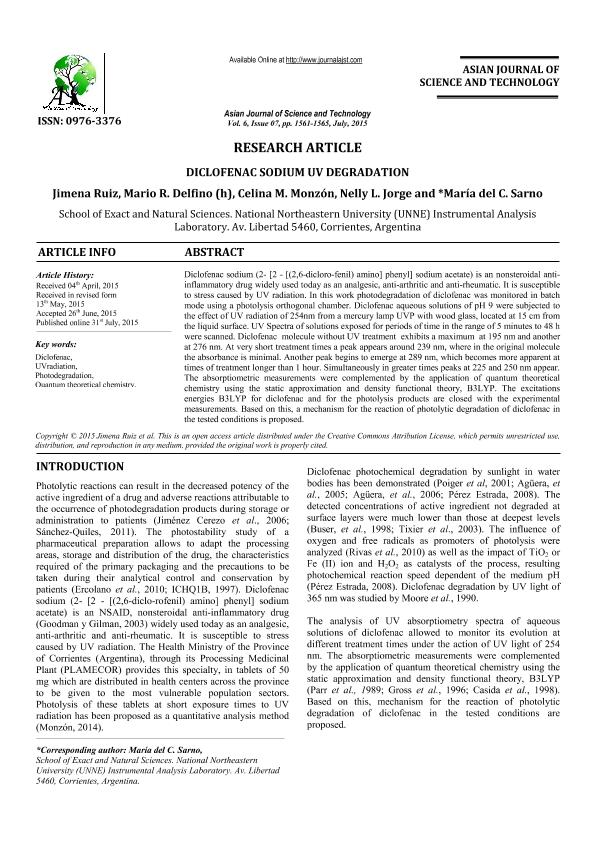Artículo
Diclofenac Sodium UV degradation
Ruiz, Jimena; Delfino, Mario Raul ; Monzón, Celina María
; Monzón, Celina María ; Jorge, Nelly Lidia; Sarno, María del Carmen Teresa
; Jorge, Nelly Lidia; Sarno, María del Carmen Teresa
 ; Monzón, Celina María
; Monzón, Celina María ; Jorge, Nelly Lidia; Sarno, María del Carmen Teresa
; Jorge, Nelly Lidia; Sarno, María del Carmen Teresa
Fecha de publicación:
07/2015
Editorial:
Asian Journal of Science and Technology Publishers
Revista:
Asian Journal of Science and Technology
ISSN:
0976-3376
Idioma:
Inglés
Tipo de recurso:
Artículo publicado
Clasificación temática:
Resumen
Diclofenac sodium (2- [2 - [(2,6-dicloro-fenil) amino] phenyl] sodium acetate) is an nonsteroidal anti-inflammatory drug widely used today as an analgesic, anti-arthritic and anti-rheumatic. It is susceptible to stress caused by UV radiation. In this work photodegradation of diclofenac was monitored in batch mode using a photolysis orthogonal chamber. Diclofenac aqueous solutions of pH 9 were subjected to the effect of UV radiation of 254nm from a mercury lamp UVP with wood glass, located at 15 cm from the liquid surface. UV Spectra of solutions exposed for periods of time in the range of 5 minutes to 48 h were scanned. Diclofenac molecule without UV treatment exhibits a maximum at 195 nm and another at 276 nm. At very short treatment times a peak appears around 239 nm, where in the original molecule the absorbance is minimal. Another peak begins to emerge at 289 nm, which becomes more apparent at times of treatment longer than 1 hour. Simultaneously in greater times peaks at 225 and 250 nm appear. The absorptiometric measurements were complemented by the application of quantum theoretical chemistry using the static approximation and density functional theory, B3LYP. The excitations energies B3LYP for diclofenac and for the photolysis products are closed with the experimental measurements. Based on this, a mechanism for the reaction of photolytic degradation of diclofenac in the tested conditions is proposed
Palabras clave:
Diclofenac
,
Uv Radiation
,
Photodegradation
,
Quantum Theoretical Chemistry
Archivos asociados
Licencia
Identificadores
Colecciones
Articulos(IQUIBA-NEA)
Articulos de INSTITUTO DE QUIMICA BASICA Y APLICADA DEL NORDESTE ARGENTINO
Articulos de INSTITUTO DE QUIMICA BASICA Y APLICADA DEL NORDESTE ARGENTINO
Citación
Ruiz, Jimena; Delfino, Mario Raul; Monzón, Celina María; Jorge, Nelly Lidia; Sarno, María del Carmen Teresa; Diclofenac Sodium UV degradation; Asian Journal of Science and Technology Publishers; Asian Journal of Science and Technology; 6; 7; 7-2015; 1561-1565
Compartir



